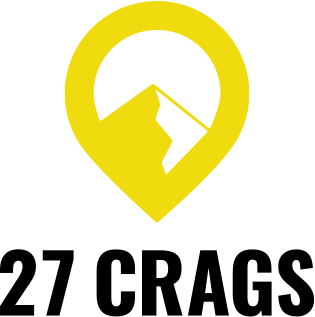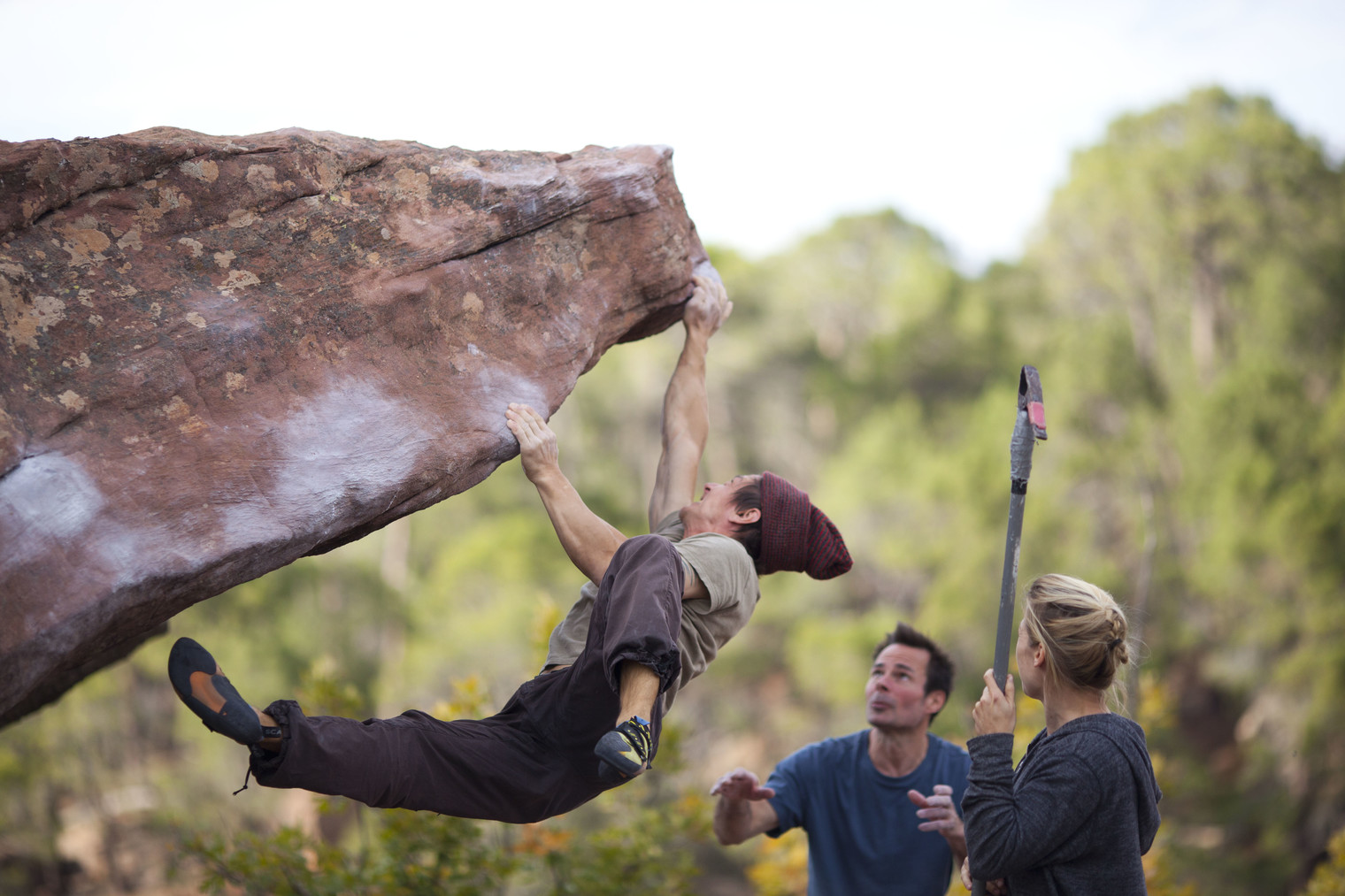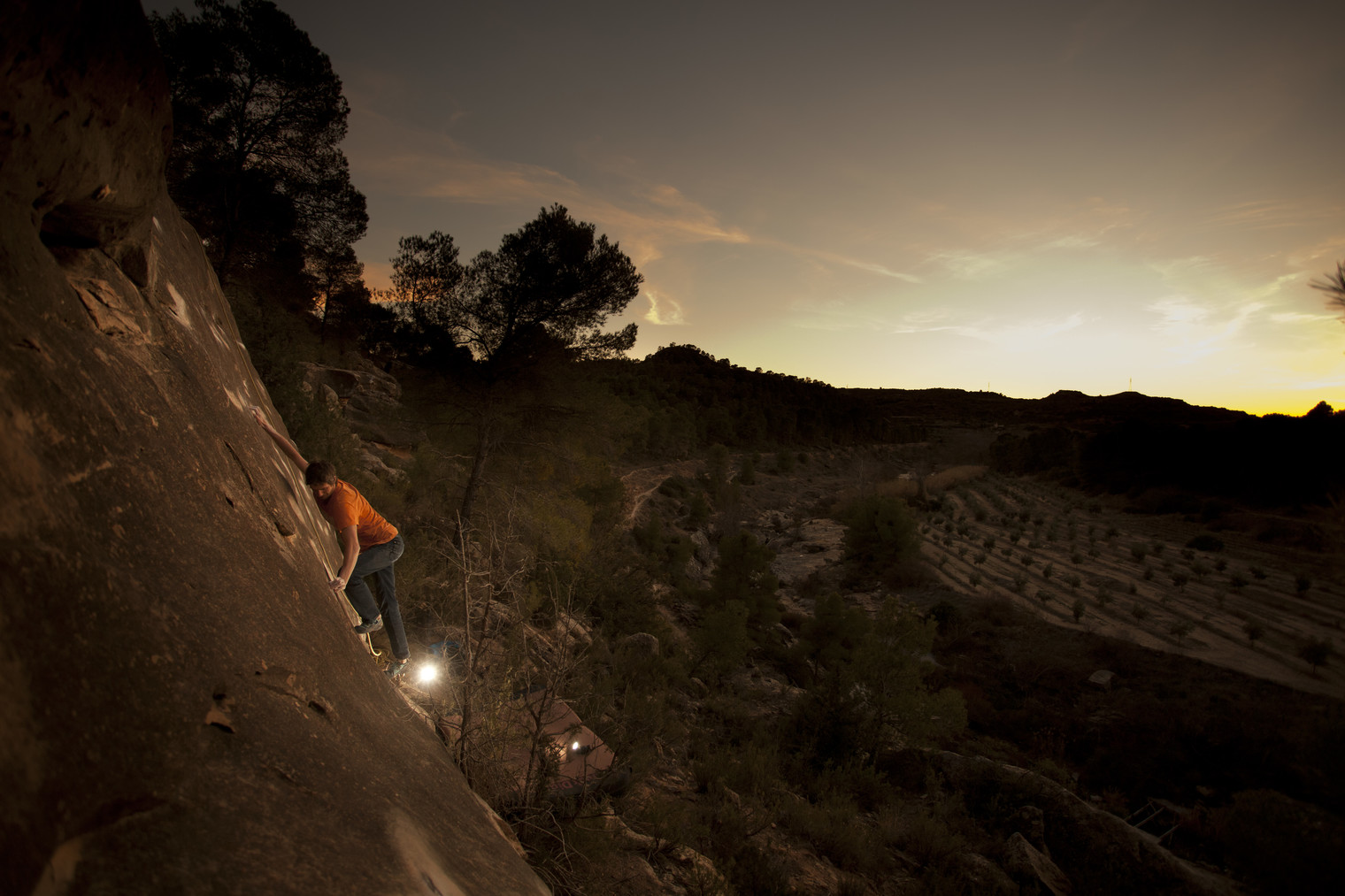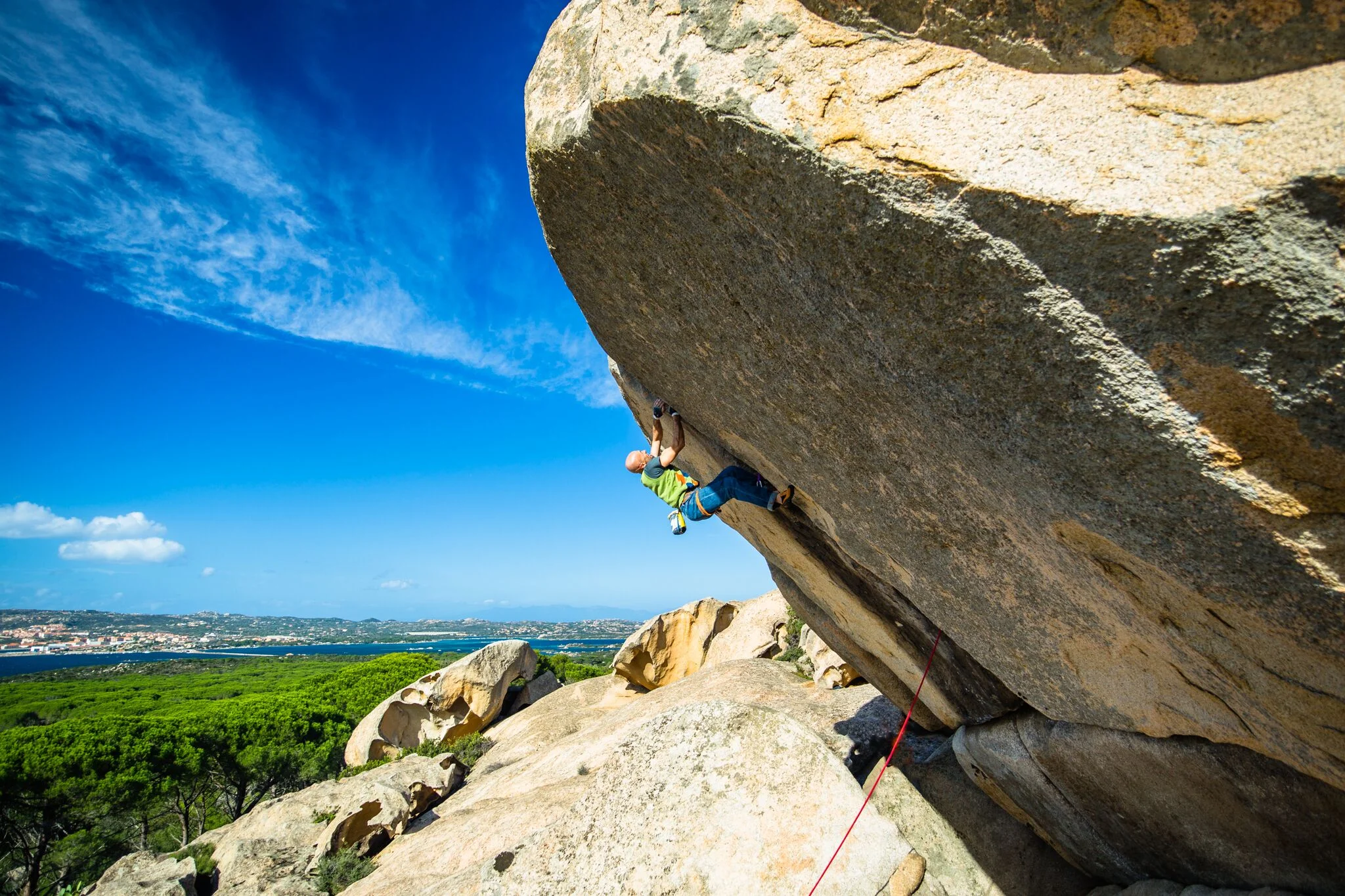Albarracín Bouldering - Ultimate Destination Guide
Albarracín, also known as the "Spanish Fontainebleau", is a red sandstone bouldering paradise situated close to Teruel, in the middle of Madrid, Barcelona and Valencia.
Albarracín offers around 1600 problems on a compact area, and it's perfect for those looking for an efficient place where it's easy to climb a lot in a short time.
This article and the video below will offer you everything you need to know when planning your trip to Albarracín! If you’re looking for the very best problems, check out another blog about them here.
For Who?
As Albarracín offers hundreds of problems in all grades and different styles it's guaranteed that everyone finds problems to enjoy. Especially grades between 6A-7B are well represented.
Nils Favre reaching for the small hold of Zatoichi (8A) in Valle de la Madera sector. Photo by Hanna Vartia.
As the climbing style resembles indoor climbing and the grades follow that somewhat as well, Albarracín is a smooth landing for those who are planning their first outdoor climbing trip.
Albarracin is also a great place for families. There’s many different accommodation options, approaches are mainly short and on easy terrain, and the area around the rocks is usually safe for kids to play around.
Climbing Area
Nils Favre on not so frequently repeated highball Zartako (8A+) in Arrastradero. Photo by Hanna Vartia.
All the boulders are located in rather compact area with few different parking areas. There’s approximately 10-15 sectors all offering high quality problems to work on.
The climbing is on high quality red sandstone and offers a great amount of indoor style roofs and overhangs. Besides these Albarracín offers different styles ranging from slabs to some of the worlds hardest top outs!
One could though say that a typical Albarracín problem starts with a pockety roof and ends with a mantel on slopers. When it comes to training before the trip, overhanging routes and mantels are the ones to go for!
Please note: Some of the bouldering sectors have closed down during the last few years. Please pay attention not to climb in the forbidden areas! All the topos in 27 Crags are only from the allowed areas, and you can find the list of forbidden areas here.
Topos
You can find the list of all the sectors and the most complete guidebook of Albarracín from 27 Crags .premium. Besides Albarracín, 27 Crags .premium gives you access to 650+ climbing topos all over the world!
Our digital guidebooks give you also access to GPS trails make sure you'll find your way straight to the right rocks and the website and app give you an easy way to keep track of ticks and todos.
Arrastradero
The biggest and most popular sector is Arrastradero with more than 400 problems. This is a must visit sector when coming to Albarracin. Due to the popularity, if possible, it’s better to head here during the week if you want to avoid the crowds.
Techo de Menos, 6c problem in Arrastradero. Photographer: Seppo Iivonen.
Arrastradero will have something for everyone and the rock quality is excellent. Especially routes between 6A-7B are well represented. The approach is approximately 10 minutes and the area is very suitable for families.
Tierra Media
El hobbit FA by Anttoni in Tierra media. Photographer: Anssi Laatikainen.
Tierra Media is a sector that also offers more than 250 problems but due to the fact that it’s located a bit further from the closest parking, it tends to stay rather calm even during weekends.
27 Crags GPS trails guide you to the right place.
The rock quality and style is different from other sectors and whereas there’s few roofs for the fans of those, the style is in general more crimpy, sharp and technical.
There’s two approaches going to the sector, one a bit shorter one with rather heavy 50m elevation, and a longer one which is easier but also a bit longer. It’s rather easy to get lost on the approach, but luckily you can also use GPS trails to make sure you find the shortest way to the right rocks.
Tierra media also offers a huge potential for new lines, both easy and hard. Bring enough food and water with you and you'll have an awesome day.
Techos
Techos is another big area with a plenty of classics. It is a bit of a walk there, but when you get there you won't regret it.
Miha doing Cosmos 8A Techos. Photographer: Mikael Uponen
Techos is unique because it's possible to climb several problems even when it's raining, thanks to the amazing roofs over the actual boulders. There is definitely something for everyone in this area, slabs, roofs, overhangs and huge dynos.
Practicalities
Getting there
Albarracin is located in Spain close to Teruel, approximately between Madrid and Barcelona. Easiest way is to fly to either Barcelona (4,5h drive), Madrid (3h drive) or Valencia (2h drive) and rent a car from the airport.
A car is recommended to get around in Albarracin, because the rocks are a 4 km drive from the village. The roads are in good shape all the way to the bouldering parking areas and the swirly road is pleasant to drive.
Arriving without car is possible but tricky, since there is only one bus per day from Teruel into Albarracin.
When to go
Driving from the village to the bouldering area.
Due to its unique location at 1200 meters above sea level, Albarracín has almost bulletproof weather and the season can stretch all the way from September to May.
Sometimes during the winter you might get snow or rain, but you’re rewarded with excellent friction when the rocks are dry. The roofs offer protection and make climbing possible, even when it’s raining. Summer might be too warm but it's still possible to climb early/late and in shady valleys.
Accommodation
Due to the climbers and other tourists visiting Albarracin, you have many accommodation options in the village.
Albarracin Camping.
You can find guesthouses, hotels, AirBnBs and a campsite so there’s a suitable options for everyone.
If you're looking for the accommodations preferred by climbers, these are great options:
Sandstone Guesthouse - Cozy guesthouse especially for climbers. Rooms with common kitchen and hanging out space. Also crashpad rental available!
Don Pepo Guesthouse - Another pleasant guesthouse with private rooms and shared common space. The owner Jorge is very friendly host and is happy to give you tips for climbing!
Albarracín Camping - Big and well equipped camping site which offers bungalows too for those who don't have tents of cars to stay in.
Groceries and shopping
Checking the climbing gear at Sofaboulder climbing shop.
In the village you can find bakeries and two small grocery stores. For bigger shoppings you need to drive about 40min to Teruel, so you might want to schedule your grocery shopping for rest days.
If you need climbing gear during your trip, you’ll find everything you need for boudering from Sofaboulder. It is also possible to rent crashpads here.
See all the accommodations and shops on the map here.
Eating out
Albarracín also offers many great restaurants to choose from, and tapas and other local delicates are not hard to find. If you’re with a big group you might want to make a reservation during the weekends when restaurants get busy from tourists.
Climbers bar La Zahora.
The popularity affects unfortunately also to the pricing, so Albarracin is not the cheapest place in Spain. You can get a pizza for around 8 euro and meal in other restaurants costs usually 10-20 euro.
If you're looking for a place where climbers tend to gather up, restaurant/bar La Zahora is the choice. It offers great burgers and craft beers in a relaxed athmosphere and you're guaranteed to find climbers from the tables next to you.
What else is there than bouldering?
Village of Albarracín.
The small and charming village of Albarracin is considered as one of the most beautiful villages in Spain. I has approximately 1000 inhabitants and attracts, besides climbers, plenty of cultural tourists.
The village and the castle, which throw you back to middle ages, are definitely worth a stroll when you want to give your aching arms a rest.
Rules and nature
As in every climbing area, behaving correctly and respecting the nature is crucial in Albarracin. There’s some areas where climbing is forbidden all year round due the bird nesting and protecting the nature.
Classic problem Saltimbanqui 7B in Cabrerizo Albarracín. Photographer: Mikael Uponen
These restrictions have been placed cause some climbers did not respect the nesting periods, that had been placed before. Following these rules is crucial not only to protect the nature, but also that bouldering in Albarracín would be possible also in the future.
Besides the basic rules of no litter and minimazing the chalk use, it is forbidden to climb during the night in Albarracin, so NO headlamp sessions are allowed.
Bouldering close to one of the most beautiful villages in the world on great sandstone can't be that terrible of a travel choice?
Extra: 1700+ problems more in near by bouldering area Alcañiz
A rather new bouldering area that has got more attention lately is Alcañiz, which is about 2,5h drive from Albarracín towards Barcelona.
Alcañiz offers hundreds of problems and when compared to Albarracín, the style is very different. Here you will find more technical slabs and vertical climbs but also some roof problems.
If you're in Albarracín and the weather forecast promises rain for the next days, it's definitely worth checking how it looks in Alcañiz.
The area seems to have even more bulletproof weather, and when it rains everywhere else it might be perfectly fine to climb here.
The most complete topos of Alcañiz which are maintained by the local climbing association can be found from 27 Crags .premium.
(P.S: With 27 Crags .premium subscription you get both Albarracín and Alcañiz topos with the same price! AND as always, all the hundreds of other topos too.
Text by Hanna Vartia, who's working as a marketing manager at 27 Crags, loves Albarracín and prefers her rock 5 meters high.
27 Crags topos are made by local climbing area developers and enthusiasts. From the .premium subscriptions 50% of the income will go straight to the topo authors who are doing extremely important job in developing the climbing areas.
Interested in making topos? Don't hesitate to send us an email: tim(at)27crags(dot)com
Follow us on social media:




















